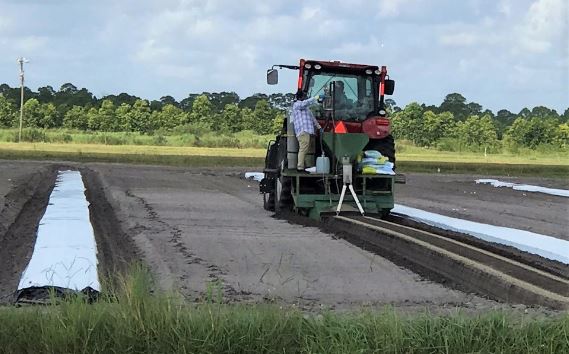
By Ramdas Kanissery and Pamela Roberts
Soil fumigation is a fundamental step for successful commercial crop production in Florida under intensive conventional systems. It has been regularly used on crops such as vegetables, strawberries and potatoes.
Soil fumigation is one of the most successful means of reducing soil pathogen and weed populations and is typically applied as a pre-plant soil injection of gas into the beds before plastic much installation. As the fumigant gas works its way through the soil, it controls many types of pests, including various soil-disease pathogens, nematodes and some weed seeds. Most crop producers, including vegetable and strawberry growers, saw their yields increase in the past decades since the advent of fumigant use.
EXISTING OPTIONS
The extensively used fumigant ingredient methyl bromide has been phased out from the industry due to its ozone-depleting characteristics. Currently, there are other fumigants available as an alternative to methyl bromide, usually with an active ingredient of chloropicrin, 1,3-dichloropropene, dimethyl disulfide or methyl isothiocyanate generators (metam sodium/metam potassium).
However, none of these alternatives individually have the broad-spectrum activity against weeds and soil-borne plant pathogens as seen with methyl bromide. As a result, they must be used in combinations to afford the same level of control. This increases the cost of production.
Also, an awareness of what pathogens are present in the soil and which weed species are problems on the farm is needed to figure out which fumigant combinations will work best for specific farms. This was not the case with methyl bromide. Therefore, with not many effective soil fumigants available and costs rising to meet the restrictions associated with the application, there is a need to identify or develop a novel, more cost-friendly fumigation system.
ALTERNATIVE APPROACH
Anhydrous ammonia is an efficient and widely used fertilizer in many parts of the world. It is relatively easy to apply and is readily available to producers. Anhydrous ammonia is injected into the soil as a cheap source of nitrogen, a practice common in crop-growing regions of the midwestern United States.
As early as the 19th century, ammonia was introduced as a chemical disinfestation agent. The evaluation of anhydrous ammonia in crop protection dates to 1955, when researchers injected the gas into a Florida sand and reduced fungi, bacteria and nematodes. A few studies followed where anhydrous ammonia was tested for its efficacy against soil-borne pathogens, including bacteria and fungi.
Anhydrous means “without water.” Because anhydrous ammonia contains little or no water, it aggressively seeks out moisture and desiccates everything that has been exposed to it, including nutsedge tubers, weed seeds or pathogen spores from the soil. However, further research is needed to understand the herbicidal, fungicidal and nematicide properties of anhydrous ammonia in soil, particularly in the setting of raised bed plasticulture systems in Florida.
In an ongoing project at the University of Florida Institute of Food and Agricultural Sciences (UF/IFAS) Southwest Florida Research and Education Center (SWFREC), researchers are evaluating the effectiveness of anhydrous ammonia as a pre-plant fumigant for controlling weeds and soil-borne pathogens in plastic-mulched raised beds (Figure 1). Researchers are testing a shank injection of anhydrous ammonia and are comparing it to untreated checks and grower standards. The application manifold and delivery lines are modified to be compatible with anhydrous ammonia for applying this fumigant in the field.
After a deep injection of anhydrous ammonia (14 to 16 inches deep from bed top), the bed was recompressed, and plastic mulch was installed immediately. The primary objective for such deep placement of anhydrous ammonia is to prevent its rapid escape for maximum control of weeds and pathogens. Most other fumigants can be placed 8 to 9 inches deep. The lateral movement of ammonia tends to be farther in coarse-textured soils and soils low in moisture — typical conditions in Florida soils.
Rapid and effective diffusion across the bed is a desired property for an effective fumigant. Although methyl bromide was able to swiftly diffuse as a gas across a bed, most of the alternatives currently available do not have the vapor pressure or chemical properties to move as fast and effectively throughout the bed.
FINAL THOUGHTS
Anhydrous ammonia used as a fertilizer may also have the potential to be used as a soil fumigant. Once injected into the soil, it will react with soil moisture and organic matter including weed seeds and nutsedge tubers. However, the extent of its retention in the soil and resulting weed or pathogen control efficacy varies greatly depending upon the depth of application and soil conditions at injection. Besides the use of anhydrous ammonia as a fumigant, addition of nitrogen in its retention zone may be a potential boost to vegetable crops.
Ramdas Kanissery is an assistant professor and Pamela Roberts is a professor, both at the UF/IFAS SWFREC in Immokalee.









